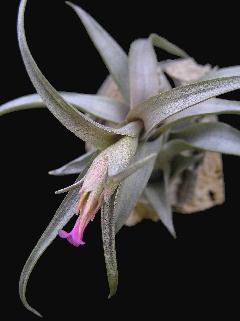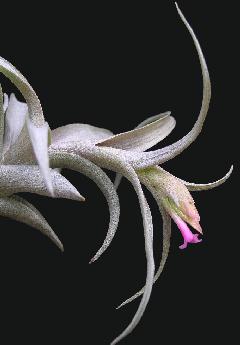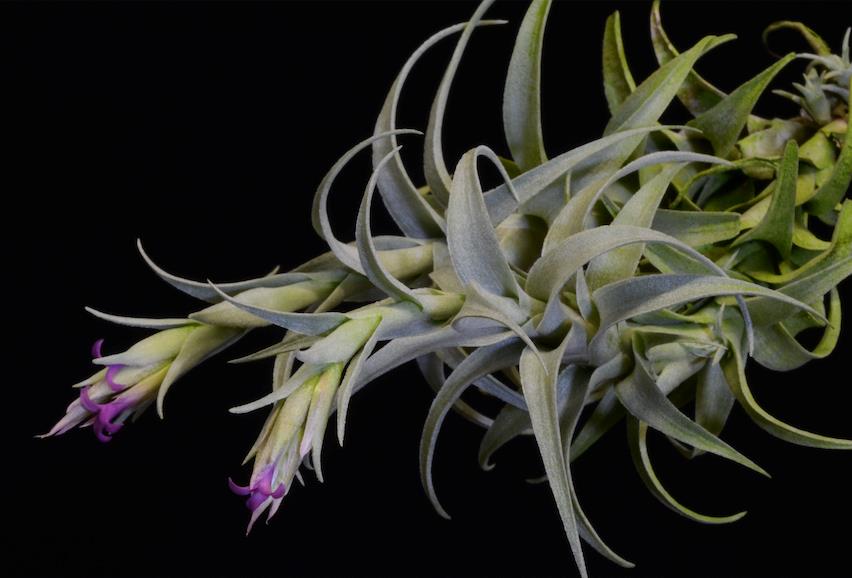


From Rauh in J. Brom. Soc. 24: 171-3. 1974
The upper limit of the Tillandsia is formed by Tillandsia oroyensis, which is named after the town Oroya. It is not a very attractive species, growing in big tuffs. Much more interesting is Tillandsia cauligera; its long stems, covered with silver-gray leaves, hang down from the rocks like snakes (Fig. 13). But the most exciting species, restricted in its distribution to a limited area, a vertical limestone cliff, is Tillandsia nana, which also forms long stems. It is a very tiny species with silver-gray leaves and blue-violet flowers, arranged in a headlike inflorescence (Fig. 14). The plant is much smaller than the related Tillandsia calocephala, widespread in the same localities in southern Peru and Bolivia (Fig. 15).
1) According to L. B. Smith (Phytologia Vol. 21, March, 1971) T. calocephala is synonomous with T. nana. In general, we agree with L. B. Smith, but the southern Peruvian T. calocephala is quite different. It is much larger than the Tarma plant and the "involucrum" beneath the flower head is more distinct.
Detail from Baker 1889
61. T. NANA Baker. -Whole plant not above 2-3 in. high. Leaves few, lanceolate, ascending, falcate, 1-2 in. long, ¼ in. broad low down, densely lepidote. Peduncle very short. Spikes 1-2, dense, distichous, 5-6-flowered, an inch long, ⅓ in. diam. ; flowerbracts ovate-lanceolate, 5/8 – 3/4 in. long. Calyx shorter than the bract. Petals not seen.
Hab. Andes of Southern Peru, C. Gay ! (Herb. Mus. Par.). Collected 1830, 1840.
From Mez 1935
316. Tillandsia calocephala Wittmack, Meded. Rijks Herb. Leiden 29: 90. 1916.
Translated by Butcher
Stature small, to 22cm long.
Leaves many, not at all rosulate, stem a little elongated, bent upwards, clothed densely in all directions, but more or less curving to one side, 6-8cm long, densely covered with subappressed lepidote scales, white, from sheath barely 1cm wide, gradually attenuate, moderately flat, above the sheath 7mm wide, narrowing to a long subulate tip.
Scape almost lacking
Inflorescence very densely capitate, barely 25mm long, 15mm diam, contracted panicle, composed of very short, few flowered spikes, primary bracts like the upper leaves, more or less enclosed
Primary bracts broad oval, long subulate
Spikes 5-6, one terminal, otherwise almost whorled, attached the whole length of the transverse axis, two edged, barely 15mm long, 2-3 flowered.
Flower bracts ovate lanceolate, flattened, strongly keeled, outside lepidote at base, acute towards the tip, deep red when dry, 10mm long, a little shorter than the sepals.
Sepals lanceolate, 12mm long, keeled, glabrous, the posterior pair joined for 2mm, white, acute towards the tip, drying to deep red as with the bracts.
Petals forming a tube with the tip bell shaped, blade lanceolate, claw a little wider, exceeds the sepals by 3-4mm, to15mm long, blade 2-3mm wide. Purple violet ( blue when dry)
Stamens a little shorter than the petals, almost exceeds the tube, filament very thin, anther 3-4mm long, pollen ovate, thick skinned.
Ovary cone shaped, 5mm high, 2mm diam, almost triangular to keeled tip.
Style long, exceeds petals by 2mm, 8mm long, stigma lobes free, short, narrow lined
Seed distinguished by very long lines, nearly filiform, 2mm long
Seed capsule unknown
Habitat - on dry rocks, gully near Rio Montehuaiko, 3500m, Bolivia (July 1911)
Detail on T. calocephala in Wittmack 1916
The inflorescence is similar to the larger Tillandsia sphaerocephala Baker, that is also native to Bolivia near Sorate at 3100 m high (Mandon nr., 1188). Regarding the somewhat secund leaves and the form of the individual flowers it is similar to Tillandsia heteromorpha Mez in Fedde Rep. III, 41, from Peru (Weberbauer No. 3072) and because the usually only 2 flowered spike can be linked to T. geminiflora Brongn. from Brazil.
It represents so to speak the var. incana the latter species in Bolivia. T. heteromorpha has violet, tipped white petals, it differs in the much narrower, secund leaves and more adjacent lesser silver-grey scales, furthermore. T. geminiflora has rosette leaves that are longer, already red floral bracts and scarlet flowers. With T. heteromorpha and also T. geminiflora the inflorescence exceeds the leaves and much more clearly shows the panicle character; with our species havivgtype has a clear flower head, that is covered by the foliage and floral bracts almost completely, so that only the corollas can be seen. The upper leaves of a living plant spread wider so that the inflorescence becomes visible.
Quite notable are long streaks on the ovules, that are already 2 mm long and thin ribbon like at anthesis. Under a microscope you can see that these are long with longer integument on the outside.
As you know, this delivers the mop of hair at the lower end at puberty, maintaining at the Chalazar end itself forming another mop of hair. This was allowed to probably be short with our type species since the upper appendix is also very short at the ovule., (see Wittmack in Engler and Prantl, Naturl. Plant-families part II, Abtig. 4, P., 33, fig.19. u.20)
With T. geminiflora the ovules are much shorter, not linear but longish and the outer integument a little longer than the inner. I have not examined the ovules of T. heteromorpha. Brongniart gave the name geminiflora, because usually there are 2 flowers behind the floral bract, both single flowers forming quite a short spike, occasionally between the two there is another third, that can also be positioned at the back.
Tillandsia calocephala Wittmack, by Smith in Phytologia 28(1): 35. 1974
Examination of the type of T. nana shows that it has a depauperately compound inflotrescence not a single one and that consequently it equals and replaces the later T. calocephala.